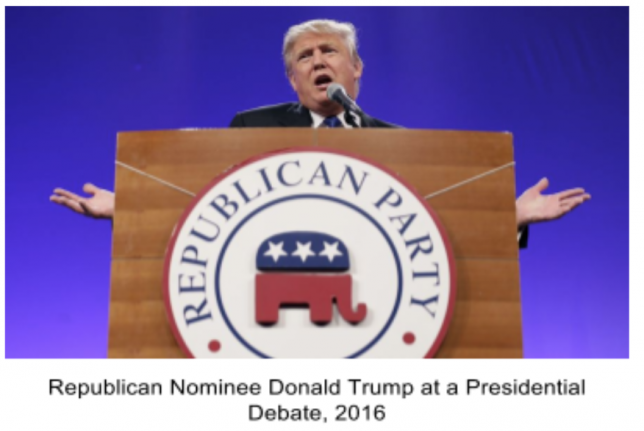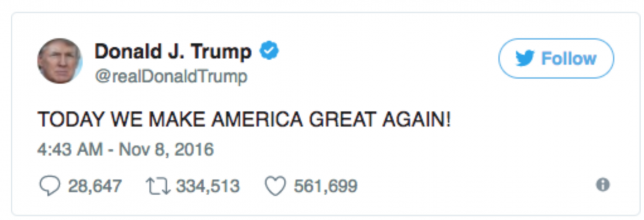PAGE NAVIGATION
- Introduction
- Context
- Key Actors
- Social Media Presence
- Offline Presence
- Impact of the Movement
- Conclusion
Introduction
This chapter of the Berkeley Guide to Social Media and Social Movements pertains to the movement and presidential campaign slogan Make America Great Again. The phrase and social movement is most commonly attributed to Donald Trump, his 2016 presidential campaign, and the Republican political party. The campaign slogan has taken many forms from “Make America Great Again” to the abbreviated “MAGA” as well as the hashtags #makeamericagreatagain and #maga on social media. While it is inherently an American movement, there has been much international support (and opposition). Although the slogan has been broken down and interpreted in a myriad of ways, this chapter will attempt to provide an unbiased and detailed analysis of Make America Great Again. Beyond that, an analysis will be consistent throughout of how social media propelled Donald Trump to the white house and helped him win the 2016 elections.
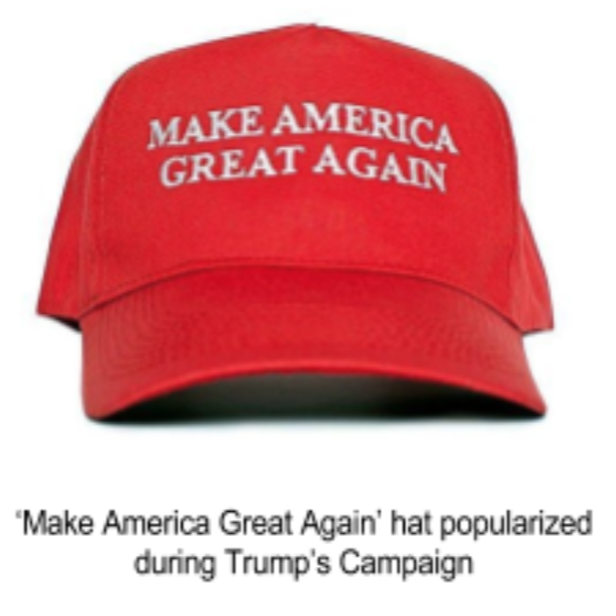
Context/History
Although most people solely attribute Make America Great Again to Donald Trump and his 2016 presidential campaign, there have been noteworthy instances of its usage in previous elections. Ronald Reagan was the first to use the (albeit slightly different) slogan during his 1980 presidential campaign by coining the phrase “Let’s Make America Great Again”[1]. At the time of his campaign, the United States was suffering from an economy experiencing high inflation and unemployment rates combined with a declining economic growth rate, known as stagflation[2]. Reagan brought this economic adversity to the forefront of his campaign and used his slogan to evoke a sense of patriotism among the electorate. His efforts proved effective as he won the general election by a landslide and obtained the greatest number of electoral votes (489) ever for a non-incumbent presidential candidate[3]. The phrase was later used in several speeches by Bill Clinton in his victorious 1992 presidential campaign, although it was not his campaign slogan[4][5]. Bill Clinton also used the phrase during a radio advertisement for his wife, Hillary Clinton’s, 2008 presidential primary campaign[6][7].

Donald Trump’s claim to the phrase came a few days after Mitt Romney’s loss to Barack Obama in the 2012 presidential election. While many Republicans were still wallowing in disappointment, Trump decided that the time was right and that he “was in a good position” to make a run in the 2016 presidential election, so he began brainstorming ideas for a quality campaign expression[8]. In an interview with the Post, Trump outlined his thought process:
“I said, ‘We’ll make America great.’ And I had started off ‘We Will Make America Great.’ That was my first idea, but I didn’t like it. And then all of a sudden it was going to be ‘Make America Great.’ But that didn’t work because that was a slight to America because that means it was never great before. And it has been great before. So I said, ‘Make America Great Again.’ I said, ‘That is so good.’ I wrote it down. I went to my lawyers. I have a lot of lawyers in-house. We have many lawyers. I have got guys that handle this stuff. I said, ‘See if you can have this registered and trademarked'”[9].
Sure enough, just five days following Romney’s loss in the 2012 presidential election, Trump signed an application with the U.S. Patent and Trademark Office asking for exclusive rights to use the phrase Make America Great Again for “political action committee services, namely, promoting public awareness of political issues and fundraising in the field of politics”[10]. Donald Trump claimed that he was unaware of Reagan’s usage of the slogan until years after he came up with it.
The actual meaning of the words behind the slogan has been heavily debated throughout the length of the presidential campaign. Many members of the Left of the political spectrum and the anti-Trump faction of the Right of the political spectrum have been seen to interpret the phrase as “a racist dog whistle” or “a wink-and-a-nod at a time when women and minorities knew their place”[11][12]. However, in his book, Time to Get Tough: Making America #1 Again, Trump appears to frame his slogan and political agenda as a defense of “American exceptionalism”[13]. He writes, “Maybe my biggest beef with Obama is his view that there’s nothing special or exceptional about America—that we’re no different than any other country”[14]. The ideology of American exceptionalism relates to the concept that the United States is unique from other nations because it is based on the principles of “liberty, egalitarianism, individualism, republicanism, democracy, and laissez-faire economics.”[15] In an interview, Donald Trump explained some of the areas he believes America is currently struggling in: “I felt that jobs were hurting. I looked at the many types of illness our country had, and whether it’s at the border, whether it’s security, whether it’s law and order or lack of law and order. Then, of course, you get to trade.”[16] Simply put, Trump believed that the United States was no longer as exceptional or great in many areas as it used to be and that through his leadership and targeted legislative measures, he could revive our former prestige. 
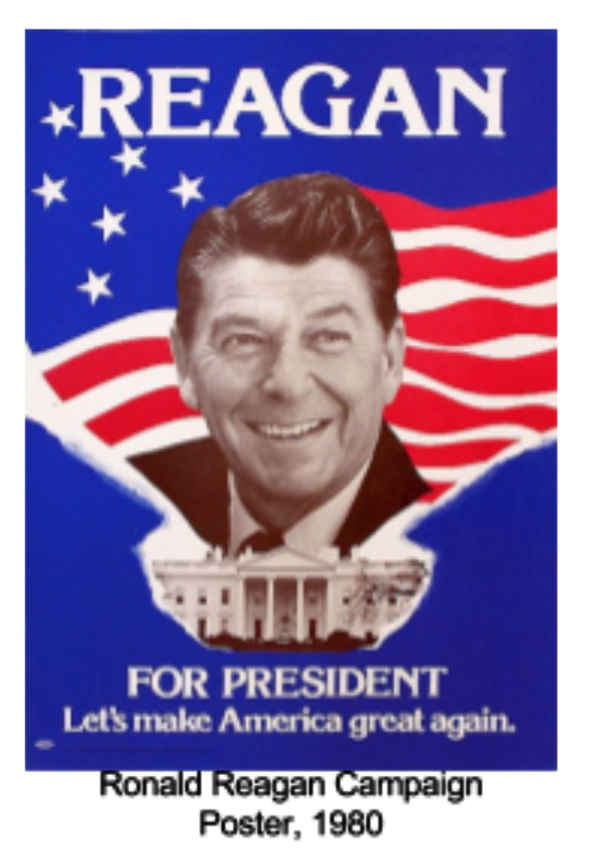
Key Actors in #MAGA
Donald Trump
The history on Donald Trump’s political position can be described as capricious. Mr. Trump registered as Republican in 1987 in New York. A decade later (1988), he left the party and stayed independent for 13 years until 2001, at which time, he changed his party to Democratic. In an interview with CNN in 2004, he told reporters that he didn’t see himself as Republican[17]. He did not return to the Republican Party until 2009[18]. Interestingly, Donald Trump made his majority of political donations to the Democratic party until 2010. It was speculated that he had decided to run as Republican at that point and use this donation to grow his political power in the Republican party. Donald Trump was never elected as any sort of government official nor did he hold any other political position. He made his debut in the political realm in 2010 when he openly questioned whether the, then, President of the United States, Barack Obama was actually born in the United States. Although Barack was born in the US, Trump gathered his first group of supporters behind the idea that Barack wasn’t, which came to be known “birtherism”[19][20]. It was not until five years later, during his 2016 presidential campaign, that Trump stopped propagating this so-called “birtherism.”
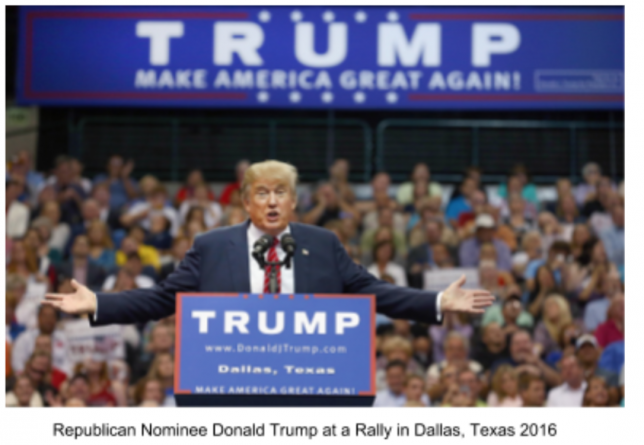
Donald Trump attempted to run for president several times before 2016[21]. Trump sought nomination by the Reform Party; however, he later dropped out the race due to “dysfunction”[22]. In the 2011 presidential election, some media outlets indicated that Donald Trump had an advantage over all other Republican candidates including Mitt Romney, the final Republican nominee that year. But for some reason, Trump once again dropped out the race.
During his 2016 presidential campaign, Trump narrated a relatively pessimistic view on the future of the United States, which strongly adhered to many people’s sentiments[23]. Various polls showed that most white men without college degree voted for Trump, and that 76% of whites without college degrees believe that America’s best days were in the past[24][25][26]. Donald Trump’s promises of bringing back jobs, cutting taxes, and deporting illegal immigrants appealed to a large portion of the electorate. His slogan “Make America Great Again”is a perfect embodiment of his idea: America’s greatest time is in the past and is under decline in recent years. Several of the most agreed reasons why his supporters voted for him are: to make border stronger and safer, for greater economic growth due to Trump’s business background, and for better health care/welfare[27]. During his campaign, Trump fiercely attacked immigrants, centralized government, globalization and mass media, things many of his supporters believe are responsible for the decline of America. His campaign promises and his flamboyant style of speech won him great popularity among the electorate of many States. Combine his resonation with many Americans to the widespread platform that Twitter and Facebook provided him, he was able to sweep the nation and win the vote
Donald Trump’s Affiliates
Roger Stone
The campaign slogan, “Make America Great Again,” transcended any previous campaign slogan on social media as it became the four words that stood for Donald Trump’s presidential campaign. The key actors of Make America Great Again worked together to shape the slogan to ultimately define Trump’s campaign. To start, Roger Stone is perhaps one of the most influential actors of MAGA. As a longtime political consultant/lobbyist, Stone has aided Trump over the past two decades in his presidential campaign.[28] Stone is a divisive character that worked with Trump directly and eventually indirectly throughout the campaign. He coined the iconic MAGA slogan in a tweet in October 2011 promoting the presidency of Donald Trump: “Make America Great Again –TRUMP HUCKABEE 2012 #nomormons.”[29] Trump began to extensively use MAGA as a slogan following the reelection of Barack Obama. Stone worked for the Trump campaign as an advisor for the campaign, but his tenor was cut short as he left amid controversy.
Brad Parscale
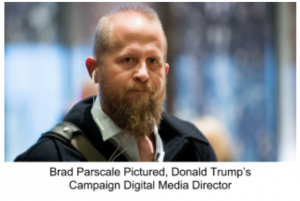
Another individual who was integral to Make America Great Again was Brad Parscale. Parscale utilized social media advertisements with an experimental strategy of different facial expressions, font colors & slogans like “Basket of Deplorable”[30]. Parscale’s specific roles included heading the oversight of advertising, both digital and TV. He was the head of the data collection,which he utilized to heavily influence his large influence on campaign fundraising.[31] Parscale claims that after realizing Virginia and Ohio were unable to be swayed, he decided to re-allocate the campaign resources to Michigan and Wisconsin.[32] This shift included the decision to send Trump to Michigan and Wisconsin and focus efforts heavily on the two states. This decision was instrumental in winning the election as Trump won both of these historically democratic states. In terms of digital advertising, Parscale utilized Facebook heavily for the campaign advertisements and even staffed Facebook employees to assist in making Trump’s Facebook platform easily navigable for target voters. Parscale did not have data scientists and was doing a lot of home-based social media work. He would also stage competitions between tech companies to find the best social media ads.[33] Parscale’s work combined with the platform provided by Facebook in particular were able to turn voters that may not have initially voted for Trump. Being able to target voters across the nation and win certain swing states like Michigan and Wisconsin would not have been possible without social media. Facebook and Twitter were the key to winning this election.
Daniel Scavino
Another key actor, Daniel Scavino, was the director of social media for the Trump Campaign and is currently serving as the White House Director of Social Media (as of December 2017). Scavino had a major influence over the various social media platform selecting Trump’s images and videos to be included in his tweets.[34] He also became notorious for targeting candidates and political adversaries with allegations. Much like Roger Stone, his allegations included the Ted Cruz affair, CNN Fake news and generally blatant attacks on any competition against Trump.[35]
The Republican Party
Although there was an unprecedented amount of tension, the Republican party played a key role in Trump’s presidential campaign. Donald Trump served throughout his on-and-off political career as a third party candidate often noncommittal to a political party. The first few months of his campaign, Trump did not associate with the Republican party. This boosted his image as an “outsider to the corruption” of politics without garnering the often negative connotation that derives from being a third party candidate with little chance to win.[36] Trump eventually signed with Republican National Committee and pledged to run as a Republican. He had a conflict-ridden journey with the Republican party, politicians in opposition to him.[37] Politicians like Jeb Bush, Ted Cruz and Paul Ryan have at one point or the other condemned Trump in different points throughout the campaign. House Speaker Paul Ryan and Ted Cruz were hesitant to support Trump for the majority of his campaign, eventually conceding to support the candidacy when he was nominated.[38] Trump utilized Twitter and his social media platforms to complain, defame and attack the various candidates in a brazen candid nature. This approach was met with massive support and backlash.[39] Many of his supporters appreciate his honesty and directness to speak out his mind; while others think he deepened the racial division and spreading out hatred. But one thing that’s clear is Trump utilized the social media platforms to reach key demographics with Parscale and Scavino leading the efforts.


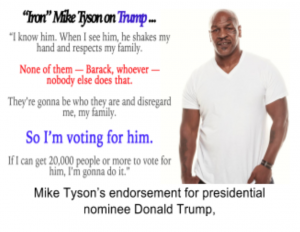
Donald Trump’s Celebrity Endorsement
Trump’s celebrity allies were much like his political allies, far and few between. Clinton amassed A-list celebrities backing her and the trending liberal twitter supported these efforts, while Trump was met with a lack of any clear A-list supporters. His celebrity endorsement was filled with many obscure vows of allegiances to Trump from relatively irrelevant actors (as compared to Hillary’s support). A few of Trump’s noteworthy celebrity supporters include Jon Voight, Gene Simmons, Hulk Hogan, Ted Nugent and Mike Tyson.[40] In the 2016 Republican National Convention, Trump received support from Scott Baio (actor), Willie Robertson (Duck Dynasty), Antonio Saboto Jr. (Dancing withthe Stars, season 19), and Kid Rock (potential Senate nominee). This hailed in comparison to the Democratic National Convention who amassed A-list stars like Meryl Streep, Bradley Cooper, Eva Longoria, Alicia Keys and Katy Perry.[41]
Demographics
The divide in the demographics of the Trump and Clinton campaign speaks volumes to why Trump and his slogan “Make America Great Again” shocked the nation. Social media played a large role in shaping the public’s perception this election. Specifically, Twitter played a huge role in the overestimated support for Clinton. During the campaign, Trump was projected to lose by most pundits and major media networks. These incorrect projections combined with Twitter’s young, liberal users conveyed overwhelming support for Clinton. The silent majority proved to be MAGA’s biggest ally in the election as older, white voters turned out for the election. Only 40% of the 18-29 age group showed out for the election, while 67.5% of 45-60+ showed out for the election.[42] This gap in voters per age group helped vault Trump to presidency.
Social Media Presence
Platforms, Hashtags and Statistics
Donald Trump took the campaign slogan to social media (primarily Twitter), using the hashtag #makeamericagreatagain and its abbreviation #maga. Many found Trump’s frequent use of social media to be unprofessional; however, Trump defended himself by tweeting “My use of social media is not Presidential – it’s MODERN DAY PRESIDENTIAL. Make America Great Again!” on July 1st, 2017[43]. In the first half of 2017 alone, Trump has repeated his slogan on Twitter 33 times. In an article for Bloomberg, Whitehouse noted: “A regression analysis suggests the phrase adds (very roughly) 51,000 to a post’s retweet-and-favorite count, which is a big deal given that the average Trump tweet attracts a total of 107,000”[44]. Trump attributed social media to his victory when he said: “I won the 2016 election with interviews, speeches, and social media.”[45] Trump acknowledges the importance that social media had in his victory as he utilized his voice strategically. His ability to see the full-scope of his presence on social media vaulted him to the top. According to RiteTag, the estimated hourly statistics for #maga on Twitter alone include 1046 unique tweets, 6,300,000 hashtag exposure, and 3600 retweets with 12% of #maga tweets including images, 59% including links, and 52% including mentions[46]. Note: these figures would be even greater if all derivatives of the slogan across all social media platforms were taken into account. Trump’s Twitter handle is @realDonaldTrump, and his account had 40.5M followers as of October 2017.
Meme vs. Cause
Reddit & 4chan
“We actually elected a meme as president”[47]declared 4chan’s /pol/ board. The impact that 4chan and Reddit played in the campaign of Donald Trump was tremendous as 4chan’s /pol/ and Reddit’s r/The_Donald forums were a haven for MAGA supporters.
Following Trump’s bid to run in the 2016 Republican Primaries, the subreddit r/The_Donald was created. Reddit is a collection of its various subreddits like r/news, r/askreddit and basically, any topic that comes to mind likely has a subreddit. 4chan, on the other hand has a set of various forums like /pol/ which is labeled “Politics.” During the campaign, r/The_Donald grew tremendously and became a trending subreddit 4 times, allowing it to grow exponentially.[48] Reddit’s influence must not be underestimated as it is the fourth most popular website in the U.S. with an average time spent on the website clocking in at sixteen minutes, the highest amount among the top twenty-five websites.[49]Thus, as The_Donald grew, its influence became apparent, as subscribers upvoted the posts to the ‘front page’ of Reddit. In the example on the next page, there is an example of an r/The_Donald post making it to the front page.
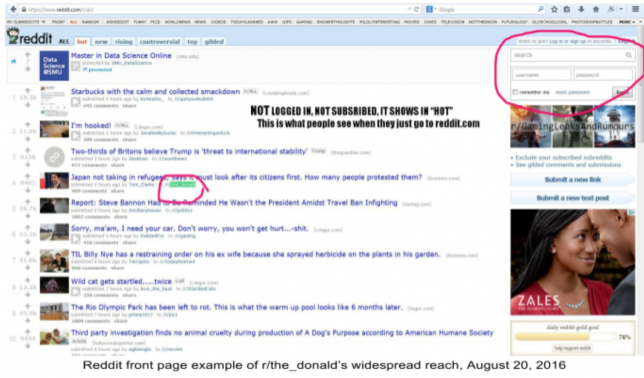

This became common ground during the election as posts like the one pictured above flooded the front page in waves as to their credit, the subreddit was a tightknit community with a goal in mind: to elect Donald Trump and get their posts to the front page. This community as of October 21, 2017, has over 500,000 subscribers, which is smaller than pages like r/nba or r/malefashionadvice which each respectively have much more subscribers. Yet, r/The_Donald did everything in its power to utilize its platform, much like President Trump. Their zealous attitude propelled Donald Trump to being consistently viewed on the top page. This consistent viewership was one of the staples of Trump’s campaign as he dominated the media cycle beyond Reddit via TV outlets, news coverage, etc. The more coverage he received, the better as his candidacy became increasingly validated allowing him to become entrenched as the alternative to Hillary Clinton. On June 16, 2016, Reddit changed its Front Page algorithm claiming “as a community is represented more and more often in the listing, the hotness of its posts will be increasingly lessened. This results in more variety in r/all.”[50] This algorithm hastened the amount of r/the_Donald posts on the front page and was a controversial shift that caused a lot of anger in the subreddit.
Despite any intentional or unintentional move to limit its front page visibility, r/The_Donald drove on amassing incredible viewership as the election grew closer.
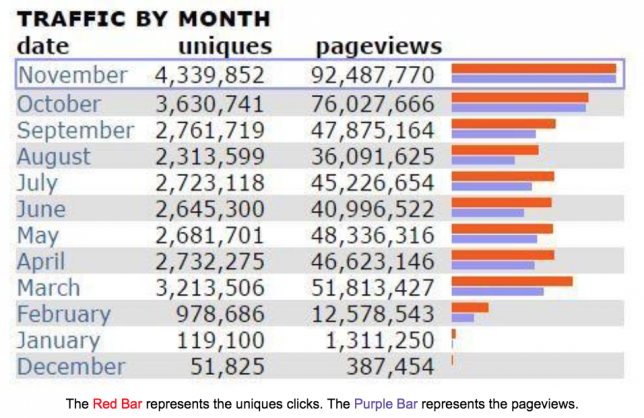
The Red Bar represents the uniques clicks. The Purple Bar represents the pageviews.
Blurry Line Between Supporters vs. Trolls
The subscribers of r/The_Donald and 4chan users on /pol/ walked a fine line often between being just a meme compared to actually supporting Trump. What resulted was an unclear distinction between actual Trump supporters and people merely trolling. Many posts on r/The_Donald contain a cheeky headline often with meme terminology that raise the question. Is this user and its supporters upvoting to support Trump or to applaud the subtle humor? The jokes are often so layered and ‘Meta’ that the Meme became a reality. An interesting group that has a large presence on r/The_Donald and more so on 4chan’s /pol/ is the Alt-Right. Many alt-right supporters are Trump supporters, with Alt-Right leader Richard Spenser supporting Donald Trump.
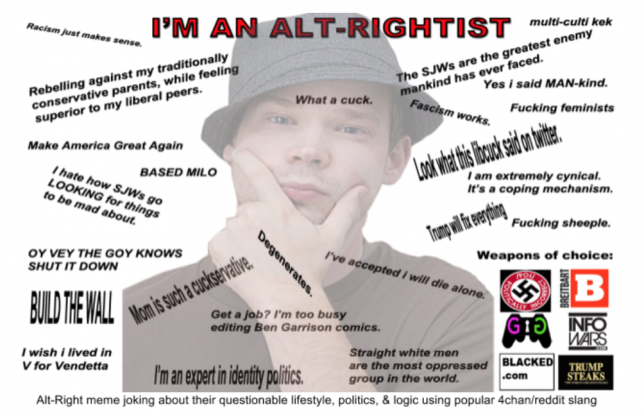
In response to the previously mentioned algorithm change that hurt r/The_Donald’s visibility, this ‘shitpost’ below became one of the highest upvoted posts all time on r/The_Donald. One user submitted a post asking for a photo of then President Obama to be the highest upvoted post on reddit. In response, a user created this ‘shitpost’ as a criticism of Obama’s drone usage and its civilian casualties. r/The_Donald gives no indication of how much people actually believe the message of the post compared to simply upvoting the post as a joke to get it to the front page.

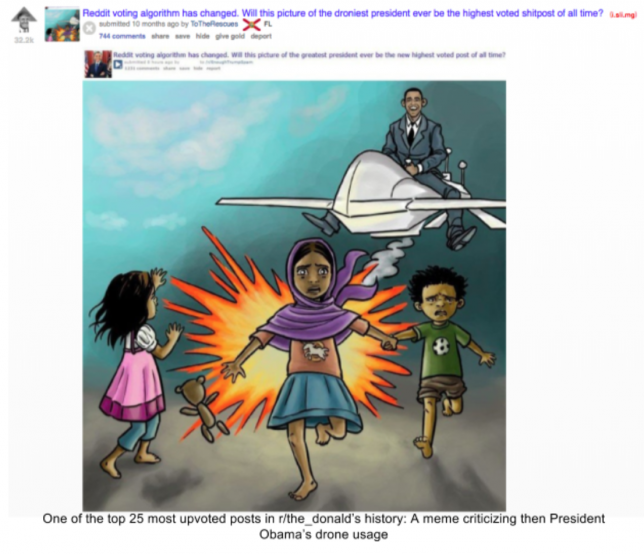
5 Noteworthy Tweets
Donald Trump sent out this tweet in the early morning of on Election Day. The tweet was simple and to the point, following the slogan “Make America Great Again” that he used throughout his campaign. The immense number of engagements indicated his support, and the tweet probably inspired people to cast their last-minute votes.
2) 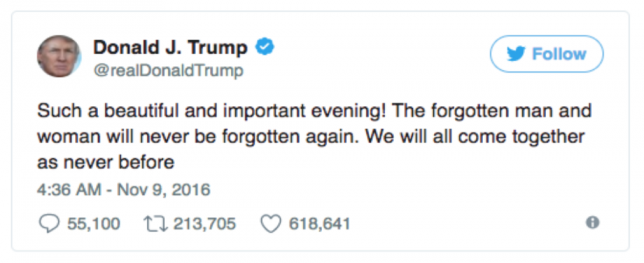
This was the first tweet Trump sent out as president-elect. It echoed some the key points of his victory speech regarding the economically neglected and achieving national unity. The message (and even the word “again”) directly relate to his campaign slogan and movement.
3) 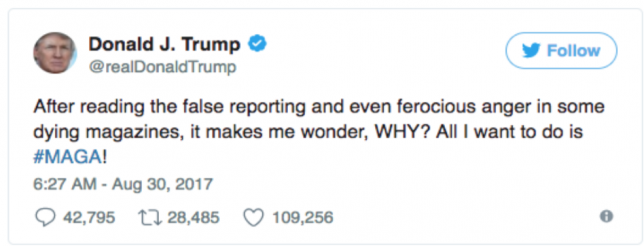
In this tweet, Trump attacks “Fake News” and the negative media coverage of his presidency. He again points to his simple campaign slogan and promise to Make America Great Again.
4) 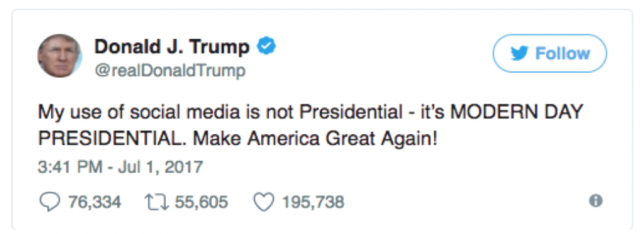
Throughout his 2016 presidential campaign as well as into his presidency, Trump has received much criticism over his unconventional use of social media. In this tweet, he directly defends his actions online as being “modern – day presidential.” He again ends his tweet with his famous slogan Make America Great Again.
5) 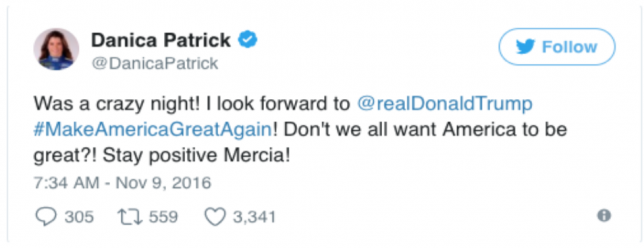
In this tweet, professional stock car racing driver, model, and advertising spokeswoman, Danica Patrick, celebrates Trump’s presidential victory by further propagating his promise to Make America Great Again.
Criticism on Social Media
Trump Election Win
However, as mentioned previously, the majority of noteworthy celebrities and active Twitter users opposed Donald Trump (and supported Hillary Clinton). Many tweeted messages of hope and encouraged their fans to unite following Trump’s surprising victory, while others expressed disbelief and devastation
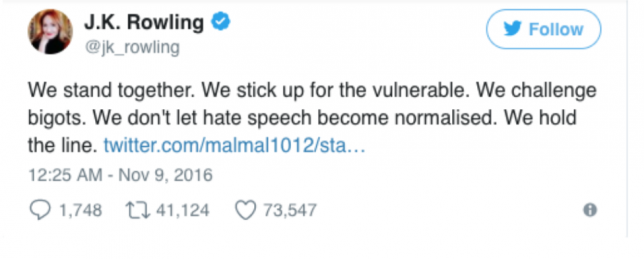
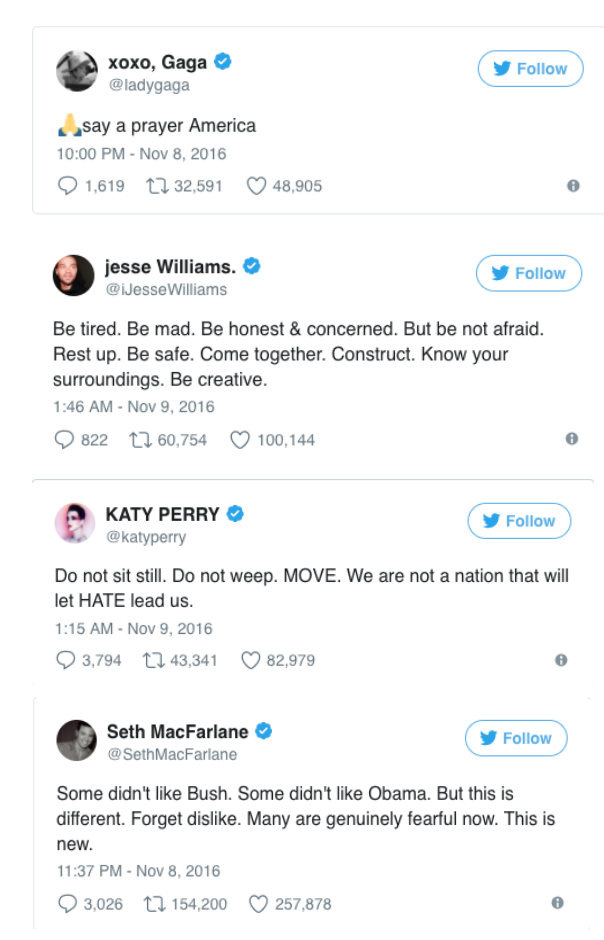
Many television presenters, editors, late night show hosts constantly attack Trump’s anti-intellectual, anti-semitism, anti-globalism position, including Anderson Cooper, Seth Meyers, Bill Maher, Stephen Colbert, Don Lemon, Jake Tapper. They hope Trump could keep an open mind and unbiased stance on many issues.
Offline Presence
MAGA Related Protests
Trump’s controversial rhetoric instigated heated debate and extreme actions from both supporters and opponents. Numerous anti-Trump and pro-Trump rallies/protests took place at different locations since Donald Trump announced his campaigning for 2017 president[51][52]. On January 21st, the next day after Trump inauguration, around 500,000 people joined Women’s March taken place in Washington DC[53]. Although this march indented to advocate women’s rights and LGBTQ rights, its date and location insinuated the opposition against Trump’s position on these issues, especially his foul language on women in an exposed audio recording tape. The Women’s March spread worldwide with around five million people participating in the protests. Since then many rallies, movements and protests were organized in order to show their opposition against Trump such as “United Against Hate”, “#resist”, “#StopHateDumpTrump”. Their main ideas are to stop the spreading of hate, racism, xenophobia, white supremacy and nationalism. 
This event was widely talked about for a while due to its deep implication of how this slogan should be interpreted. Although both sides claim they love America and want to make it better, their ideology and approaches are drastically different. This can be reflected from their slogan during protests. Trump supporters often chant “U.S.A.”, “fake news”, “blood and soil”, “build that wall” referring to the border wall between America and Mexico Trump promised to build, and, of course, “make America great again”, signifying a conservative, nationalism-centered view. On the other hand, Trump opponents often shout “shame”, “no wall, no KKK, no racists”, “not my president”, “no bully, no Trump”, denoting the relation between Trump and far-right racism. This divide proved to be one of the defining factors of the election furthering Trump’s appeal to many Republicans. In an oddly contrived manner, Trump embraced the tension at many points and often using it as a tool to further his campaign. The aforementioned protests that were born out of social media propelled Trump as each side of the feuds became increasingly entrenched who they’re voting for.
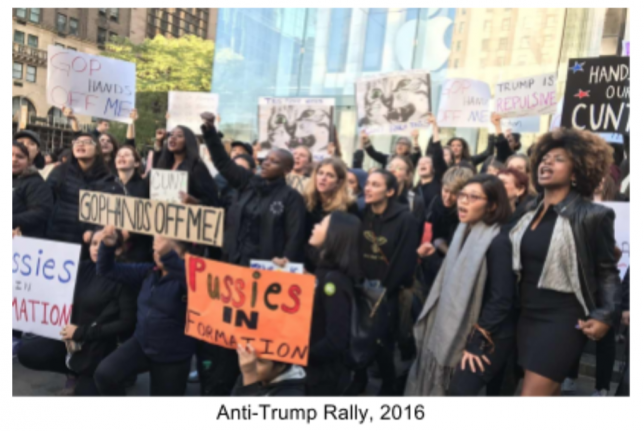
Google Trend on “Resist” and “not my president”. “Resist” peaked right after inauguration and remains prevalent. “Not my president” peaked after Trump won the election, increased again after inauguration.
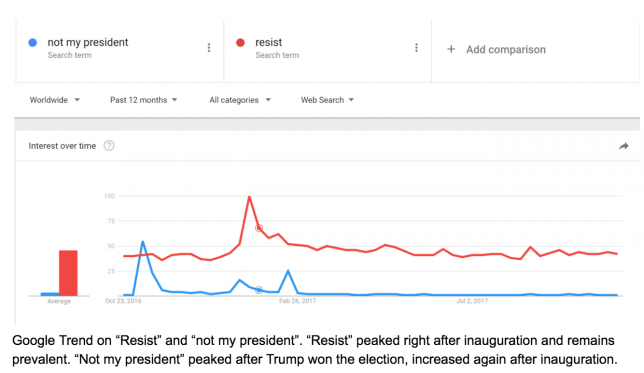
Far-Right Support
On the other hand, the “Make America Great Again” movement can be considered widespread and influential since it stimulated many far-right groups and organizations to voice out their position that was previously relatively unheard of. Trump’s controversial rhetoric instigated heated debate and extreme actions from both supporters and opponents. Numerous anti-Trump and pro-Trump rallies took place at different locations since Donald Trump announced his decision to run for president[54][55]. The clash intensified after Trump was elected president. Terms such as neo-Nazi, white supremacist, white nationalist came into public spotlight. Many groups that were previously unheard of and traditionally reside in deep southern states began to gather people up and march nationwide. Far-Right groups gained an widely visible platform to promote their white nationalist beliefs.
Google Trend showing the search occurrence of “White supremacy” (blue) and “alt-right” (red) since Trump announced running for president. Candidate Hillary Clinton’s speech on Aug 25th 2016 related Trump with alt-right group. That’s when this group entered public spotlight, proving that Donald Trump brought the group under day light. Another peak is after Trump won the presidential election and Trump’s inauguration.
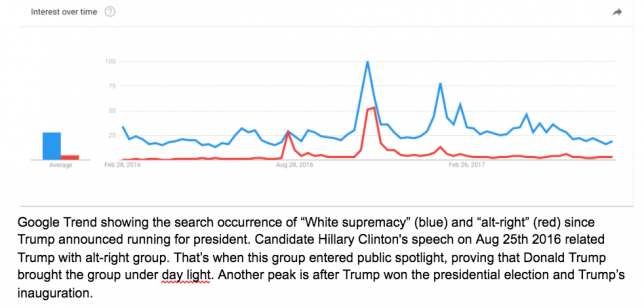
Trump supporters initiated movements such as “Unite the Right”, “Free Speech Movement (alt-right)”, “identity movement”, “neo-Nazi”, claiming to bring back America’s glory and protect America’s conservative tradition. They utilized both online social media and offline gatherings to spread their ideas and power. Besides using big co-operative social media platform like Facebook, Twitter, YouTube, many individuals created a website of their own. Some of the most popular far-right and Trump-supporting media saw incredible growth like Breitbart, Infowars, seen.life, Gab.ai, etc. These platforms cater to a more concentrated audience that share political views, providing conservative viewpoints that confirm their beliefs. Utilizing their new-found platform, hundreds of marches and protests took place in various locations throughout the U.S.. One of the most popular offline movements from Trump supporters was the far right rally at Charlottesville. At the protest, one person protesting the alt-right was killed, and nineteen others were injured after a white supremacist drove a car into the crowd. Trump offered little criticism of the alt-right claiming “fault on both sides.”[56] While many people think Trump deepened racial divide and sending signals to racism, others have taken comfort in his campaign promises.
Impact of the Movement
Trump Wins the Presidency
The largest and most direct impact of Make America Great Again was Donald Trump winning the 2016 presidential election. On November 8th, 2016 Trump was elected to be the 45th President of the United States. He secured 304 electoral votes, won 30 states, and received approximately 63 million popular votes (~3 million fewer than Hillary Clinton)[57]. Since being sworn into office, Trump has signed 53 bills into laws.
Rise of the Alt-Right
History
The Alt-Right, or Alternative Right, is a group of individuals who identify with far-right ideologies and reject mainstream conservatism in favor of white nationalism[58]. The term was initially promoted in 2010 by Richard Bertrand Spencer in reference to a movement centered on white identity, but the Associated Press (and many others) believe the term is an attempt to disguise overt racism, white supremacy, neo-fascism, and neo-Nazism[59]. Alt-right beliefs have been described as isolationist, protectionist, antisemitic and white supremacist, and they frequently overlap with Neo-Nazism, nativism and Islamophobia, anti-feminism, misogyny, homophobia, and right-wing populism[60]. The concept has further been associated with several groups from American nationalists, neo-monarchists, men’s rights advocates, and the 2016 presidential campaign of Donald Trump[61].
Connection to Trump Campaign
The term gained significant media attention and controversy during the 2016 presidential election, notably when Trump appointed Breitbart News chair Steven Bannon to be CEO of his presidential campaign in August. The appointment was interpreted by many as a signal that Trump supported the Alt-Right and its many controversial ideologies, particularly when Bannon stated that Breitbart News is “the platform for the Alt-Right”[62]. Although Trump never publicly indicated support or approval of the Alt-Right, the group was extremely vocal in their support for his presidential campaign[63]. Furthermore, many anti-Trump individuals interpreted Trump’s campaign slogan Make America Great Again to have racist and misogynistic implications that were in line with many of the Alt-Right’s ideologies. During the presidential campaign, Hillary Clinton attacked the Alt-Right for having “racist ideas…anti-Muslim, anti-immigrant, anti-women ideas” and claimed that Trump played a major role in taking the group “mainstream”[64]. Media attention of the Alt-Right continued to grow after the campaign, particularly when Richard Spencer used several Nazi propaganda terms during a post-election celebration meeting and closed with “Hail Trump, hail our people, hail victory”[65]. Supporters responded to his message by giving the Nazi salute and chanting in a similar fashion to the Sieg Heil chant used in the Nuremberg Rallies in Nazi Germany. Spencer defended himself and his supporters by claiming that the Nazi salute was given in the spirit of “irony and exuberance”[66]. It has been argued that the Alt-Right label may exist as a sort of public relations device to make the real beliefs of its supporters less clear and more acceptable to a broader audience. Although Donald Trump has publicly spoken out condemning some of the hateful ideologies of the Alt-Right, people from both sides and particularly evangelicals have called for him to take more action against the Alt-Right[67].
Conclusion
Make America Great Again at face value is a political slogan. The four words transcended the election as a variety of different interpretations instituted a divide on social media and beyond. Groups like the Alt-Right and various conservative groups have united in shifting towards an isolationist and nationalist mindset, while moderates simply saw it a promise to bring America back to its glory days. Liberals and leftist groups saw issue with the slogan because it was arguably racist and had misogynistic undertones, which manifested protests and outrage both online and offline in reaction to various Donald Trump controversies. However, regardless of its the interpretation or embodiment, the slogan proved to be a success as Donald Trump was elected President of the United States. Trump’s social media often seems random, as he rants about fake news, NFL protests, etc. Yet, there’s genius behind the madness that is Donald Trump’s social media pages. His manipulation of both the American people and the media gave immense power to every word he said. His campaign was born out of his fame and riches, but it succeeded through his social media presence. Trump is already making moves to piggyback off the success of his former campaign slogan, and has declared the slogan for his 2020 reelection campaign will be “Keep America Great.”[68]

[1] “Ronald Reagan’s 1980 Campaign Poster.” I Agree to See, www.iagreetosee.com/portfolio/make-america-great-again/.
[2] Stagflation. (2017, November 09). Retrieved December 01, 2017, from https://en.wikipedia.org/wiki/Stagflation
[3] United States presidential election, 1980. (2017, November 26). Retrieved December 01, 2017, from https://en.wikipedia.org/wiki/United_States_presidential_election,_1980
[4]“Make America Great Again – A Retrospective.” Youtube.
[5] Margolin, E. (2016, September 09). ‘Make America Great Again’-Who Said It First? Retrieved December 01, 2017, from
[6] “Make America Great Again.” Wikipedia, Wikimedia Foundation, 14 Dec. 2017
[7]“2008 Clinton Campaign Ad: Bill Clinton: Hillary Will “Make America Great Again.” Youtube.
[8]Engel, P. (2017, January 18). How Trump came up with his slogan ‘Make America Great Again’. Retrieved December 01, 2017, from http://www.businessinsider.com/trump-make-america-great-again-slogan-history-2017-1
[9]Engel, P. (2017, January 18). How Trump came up with his slogan ‘Make America Great Again’. Retrieved December 01, 2017, from http://www.businessinsider.com/trump-make-america-great-again-slogan-history-2017-1
[10] Engel, P. (2017, January 18). How Trump came up with his slogan ‘Make America Great Again’. Retrieved December 01, 2017, from http://www.businessinsider.com/trump-make-america-great-again-slogan-history-2017-1
[11] What. (2017, May 12). Retrieved December 01, 2017, from https://amgreatness.com/2017/05/09/make-america-great-really-means/
[12] Jouet, M. (2017, June 23). The real story behind “Make America Great Again”. Retrieved December 01, 2017, from http://www.motherjones.com/politics/2017/01/american-exceptionalism-maga-trump-obama/
[13] Jouet, M. (2017, June 23). The real story behind “Make America Great Again”. Retrieved December 01, 2017, from http://www.motherjones.com/politics/2017/01/american-exceptionalism-maga-trump-obama/
[14] Time to Get Tough: Making America #1 Again by Donald Trump
[15] American exceptionalism. (2017, November 25). Retrieved December 01, 2017, from https://en.wikipedia.org/wiki/American_exceptionalism
[16] Engel, P. (2017, January 18). How Trump came up with his slogan ‘Make America Great Again’. Retrieved December 01, 2017, from http://www.businessinsider.com/trump-make-america-great-again-slogan-history-2017-1
[17] Kurtzleben, D. (2015, July 28). Most of Donald Trump’s Political Money Went To Democrats – Until 5 Years Ago. Retrieved December 01, 2017, from http://www.npr.org/sections/itsallpolitics/2015/07/28/426888268/donald-trumps-flipping-political- donations
[18] Chasmar, J. (2015, June 16). Donald Trump changed political parties at least five times: report. Retrieved December 01, 2017, from http://www.washingtontimes.com/news/2015/jun/16/donald-trump-changed-political-parties-at-least-fi/
[19] Trump on Birtherism: Wrong, and Wrong. (2016, September 28). Retrieved December 01, 2017, from http://www.factcheck.org/2016/09/trump-on-birtherism-wrong-and-wrong/
[20] “Barack Obama Citizenship Conspiracy Theories.” Wikipedia, Wikimedia Foundation, 11 Dec. 2017, en.wikipedia.org/wiki/Barack_Obama_citizenship_conspiracy_theories.
[21] All the times Donald Trump has pretended to run for president. Mashable. 11 Dec 2017.http://mashable.com/2015/06/16/donald-trump-president-fake/#aEnTbcn.8aqB
[22]GuideNews, TV. “Here’s a Timeline of Every Time Donald Trump Ran for President.”TVGuide.com, 28 July 2015, www.tvguide.com/news/donald-trump-presidential-campaign-timeline/.
[23]“Reform Party of the United States of America.” Wikipedia, Wikimedia Foundation, 12 Dec. 2017, en.wikipedia.org/wiki/Reform_Party_of_the_United_States_of_America.
[24]Irwin, Neil, and Josh Katz. “The Geography of Trumpism.” The New York Times, The New York Times, 12 Mar. 2016, www.nytimes.com/2016/03/13/upshot/the-geography-of-trumpism.html.
[25]Thompson, Derek. “Who Are Donald Trump’s Supporters, Really?” The Atlantic, Atlantic Media Company, 1 Mar. 2016, www.theatlantic.com/politics/archive/2016/03/who-are-donald-trumps-supporters-really/471714/.
[26] CNN/ORC Poll: 2016 election preferences – CNNPolitics. (2015, July 27). Retrieved December 01, 2017, from http://www.cnn.com/2015/07/26/politics/cnn-orc-data/index.html
[27] Donald Trump presidential campaign, 2016. (2017, December 01). Retrieved December 01, 2017, from https://en.wikipedia.org/wiki/Donald_Trump_presidential_campaign,_2016
[28]Gilbert, Sophie. “Get Me Roger Stone Profiles the Man Who Created President Trump.” The Atlantic, Atlantic Media Company, 11 May 2017, www.theatlantic.com/entertainment/archive/2017/05/get-me-roger-stone-donald-trump-netflix/526296/.
[29] Gilbert, Sophie. “Get Me Roger Stone Profiles the Man Who Created President Trump.” The Atlantic, Atlantic Media Company, 11 May 2017, www.theatlantic.com/entertainment/archive/2017/05/get-me-roger-stone-donald-trump-netflix/526296/.
[30] “Official Donald Trump Make America Great Again Hat – Red.” Trump Make America Great Again Comittee, https://shop.donaldjtrump.com/products/official-donald-trump-make-america-great-again-cap-red
[31] Donald Trump presidential campaign, 2016. (2017, December 01). Retrieved December 01, 2017, from https://en.wikipedia.org/wiki/Donald_Trump_presidential_campaign,_2016
[32] Martin, Michael. “Trump Digital Director, Originally Paid $1,500 for Trump Website, Earned $94 Million.” Metro US, 9 Oct. 2017, www.metro.us/president-trump/brad-parscale-trump-campaign-2016-election.
[33]Martin, Michael. “Trump Digital Director, Originally Paid $1,500 for Trump Website, Earned $94 Million.” Metro US, 9 Oct. 2017, www.metro.us/president-trump/brad-parscale-trump-campaign-2016-election.
[34]“Daniel Scavino.” Ballotpedia, ballotpedia.org/Daniel_Scavino.
[35]“Daniel Scavino.” Ballotpedia, ballotpedia.org/Daniel_Scavino.
[36] Heath, Susan Page and Brad. “How Anti-Establishment Outsider Donald Trump Was Elected the 45th President of the United States.” USA Today, Gannett Satellite Information Network, 9 Nov. 2016, www.usatoday.com/story/news/politics/elections/2016/11/09/election-analysis-hillary-clinton-donald-trump/93198882/.
[37]Diamond, Jeremy. “Donald Trump Pledges Allegiance to GOP – CNNPolitics.” CNN, Cable News Network, 16 Dec. 2015, www.cnn.com/2015/12/15/politics/donald-trump-independent-bid-gop/index.html
[38]Diamond, Jeremy. “Donald Trump Pledges Allegiance to GOP – CNNPolitics.” CNN, Cable News Network, 16 Dec. 2015, www.cnn.com/2015/12/15/politics/donald-trump-independent-bid-gop/index.html
[39]Wellford, Rachel. “Here’s the List of GOP Responses to Trump’s Vulgar Comments about Groping Women.” PBS, Public Broadcasting Service, 7 Oct. 2016, www.pbs.org/newshour/politics/headline-republicans-react-trump-comments-objectifying-women.
[40]staff, amNY.com. “Trump’s Celeb Supporters: From Kirstie Alley to Tila Tequila.” Am New York, Am New York, 20 Jan. 2017, www.amny.com/news/elections/donald-trump-s-celebrity-supporters-actors-athletes-politicians-and-more-1.11807358.
[41]Stopera, Matt Stopera Dave. “Famous People At The RNC Vs. Famous People At The DNC.”BuzzFeed, www.buzzfeed.com/mjs538/famous-people-at-the-rnc-vs-famous-people-at-the-dnc.
[42]Harrington, Skye Gould and Rebecca. “7 Charts Show Who Propelled Trump to Victory.”Business Insider, Business Insider, 10 Nov. 2016, www.businessinsider.com/exit-polls-who-voted-for-trump-clinton-2016-11.
[43]Tmg. “500.” The Telegraph, Telegraph Media Group, 22 July 2016, www.telegraph.co.uk/news/2017/07/01/modern-day-presidential-donald-trump-defends-use- social-media/.
[44]Whitehouse, Mark. “’Make America Great Again’ Is Trump’s Magic Twitter Mantra.”Bloomberg.com, Bloomberg, 21 Aug. 2017, www.bloomberg.com/view/articles/2017-08-21/-make-america-great-again-is-trump-s-magic-twitter-mantra.
[45]“Donald Trump Defends Twitter Use as ‘MODERN DAY PRESIDENTIAL’.” EW.com, ew.com/tv/2017/07/01/donald-trump-modern-day-presidential/.
[46] “#Maga Hashtag Analytics.” #Maga Hashtag Analytics | RiteTag: Find the Best Hashtags, ritetag.com/hashtag-stats/maga.
[47] http://www.chicagotribune.com/bluesky/technology/ct-meme-president-4chan-trump-wp-bsi- 20161112-story.html
[48] /r/The_Donald. (2017, December 02). Retrieved December 15, 2017, from http://knowyourmeme.com/memes/sites/rthe_donald
[49] /r/The_Donald. (2017, December 02). Retrieved December 15, 2017, from http://knowyourmeme.com/memes/sites/rthe_donald
[50] Let’s all have a town hall about r/all • r/announcements. (n.d.). Retrieved December 15, 2017, from https://www.reddit.com/r/announcements/comments/4oedco/lets_all_have_a_town_hall_about_rall
[51] “Protests against Donald Trump.” Wikipedia, Wikimedia Foundation, 13 Dec.2017,en.wikipedia.org/wiki/
Protests_against_Donald_Trump.
[52] “Timeline of Protests against Donald Trump.” Wikipedia, Wikimedia Foundation, 14 Dec. 2017, en.wikipedia.org/wiki/
Timeline_of_protests_against_Donald_Trump.
[53]“2017 Women’s March.” Wikipedia, Wikimedia Foundation, 14 Dec. 2017, en.wikipedia.org/wiki/2017_Women%27s_March.
[54]“Protests against Donald Trump.” Wikipedia, Wikimedia Foundation, 13 Dec. 2017, en.wikipedia.org/wiki/
Protests_against_Donald_Trump.
[55] “Timeline of Protests against Donald Trump.” Wikipedia, Wikimedia Foundation, 12 Dec. 2017, en.wikipedia.org/wiki/
Timeline_of_protests_against_Donald_Trump#Protests_during_Trump.27s_campaign.
[56]www.washingtonpost.com/news/politics/wp/2017/08/15/trump-puts-a-fine-point-on-it-he-sides-+with-the-alt-right-in-charlottesville/+.
[57] “United States Presidential Election, 2016.” Wikipedia, Wikimedia Foundation, 14 Dec. 2017, en.wikipedia.org/wiki/United_States_presidential_election,_2016.
[58] “Alt-Right.” Wikipedia, Wikimedia Foundation, 13 Dec. 2017, en.wikipedia.org/wiki/Alt-right.
[59] “Richard B. Spencer.” Wikipedia, Wikimedia Foundation, 13 Dec. 2017, en.wikipedia.org/wiki/Richard_B._Spencer.
[60] Matthews, Dylan. “The Alt-Right Is More than Warmed-over White Supremacy. It’s That, but Way Way Weirder.” Vox, Vox, 18 Apr. 2016, www.vox.com/2016/4/18/11434098/alt-right-explained.
[61] “What’s ‘Alt-’ about the Alt-Right? – The Boston Globe.” BostonGlobe.com, 29 Aug. 2016, www.bostonglobe.com/arts/2016/08/28/what-alt-about-alt-right/QcKZ1A1u7Rxk7MSd69wU4M/story.html.
[62] Posner, Sarah. “How Donald Trump’s Campaign Chief Created an Online Haven for White Nationalists.” Mother Jones, 23 June 2017, www.motherjones.com/politics/2016/08/stephen-bannon-donald-trump-alt-right-breitbart-news/.
[63]www.latimes.com/nation/politics/trailguide/la-na-trailguide-updates-neo-nazi-alt-right-crowd-+cheers-the-1479774847-htmlstory.html.
[64]Staff, NPR. “What You Need To Know About The Alt-Right Movement.” NPR, NPR, 26 Aug. 2016, www.npr.org/
2016/08/26/491452721/the-history-of-the-alt-right.
[65] Barajas, Joshua. “Nazi Salutes ‘Done in a Spirit of Irony and Exuberance,’ Alt-Right Leader Says.” PBS, Public Broadcasting Service, 22 Nov. 2016, www.pbs.org/newshour/politics/white-nationalist.
[66] Barajas, Joshua. “Nazi Salutes ‘Done in a Spirit of Irony and Exuberance,’ Alt-Right Leader Says.” PBS, Public Broadcasting Service, 22 Nov. 2016, www.pbs.org/newshour/politics/white-nationalist.
[67]Moody, Chris. “Evangelicals Urge Trump to Condemn Alt-Right.” CNN, Cable News Network, 29 Sept. 2017, www.cnn.com/2017/09/28/politics/trump-alt-right-evangelicals/index.html.
[68]www.washingtonpost.com/politics/how-donald-trump-came-up-with-make-america-great-+again/2017/01/17/fb6acf5e-dbf7-11e6-ad42-f3375f271c9c_story.html

